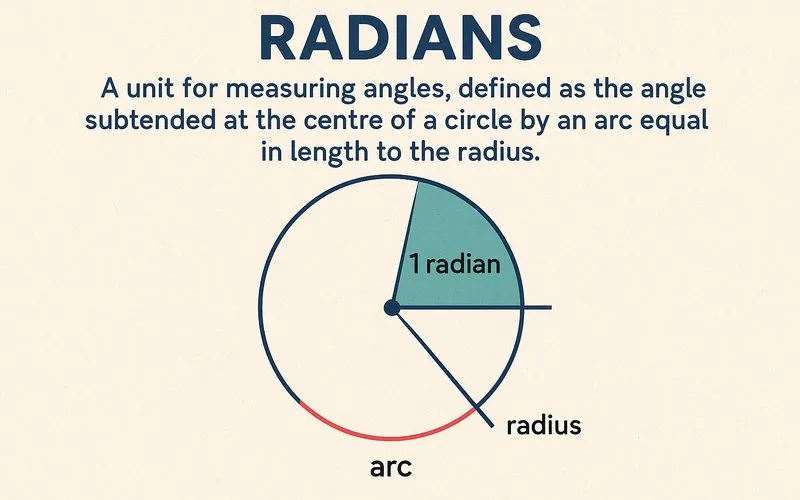Radians: The Natural Language of Circles
Why Degrees Aren't Enough
For centuries, the degree has been the most common unit for measuring angles. A full circle is 360°, a right angle is 90°, and so on. But where did 360 come from? It is believed to be from the ancient Babylonians, who used a base-60 number system and approximated the number of days in a year. While useful, this system is arbitrary. Mathematicians and scientists needed a more natural way to relate angles to the geometry of the circle itself. This is where the radian comes in.
The Fundamental Definition of a Radian
Imagine a circle. Now, take a piece of string exactly as long as the radius ($ r $) of that circle. If you were to bend this string along the circumference of the circle, the angle formed at the center of the circle, opposite that arc, is exactly 1 radian.
This definition creates a direct and beautiful relationship between the arc length ($ s $), the radius ($ r $), and the angle in radians ($ \theta $). This relationship is given by the simple formula:
$ s = r \theta $
Where:
$ s $ = arc length
$ r $ = radius
$ \theta $ = angle in radians
This formula is incredibly powerful and much simpler than its degree-based counterpart. It shows that the arc length is just the radius multiplied by the angle (in radians).
Connecting Radians and Degrees
To use radians effectively, we need to know how they relate to degrees. Let's use the arc length formula to find this relationship. The arc length of a full circle is its circumference, $ 2\pi r $. The angle for a full circle in degrees is 360°. Let $ \theta $ be the angle in radians for a full circle.
From $ s = r \theta $:
$ 2\pi r = r \theta $
Cancel the $ r $ from both sides:
$ 2\pi = \theta $
So, a full circle is $ 2\pi $ radians, which is equal to 360°. This gives us our primary conversion factors:
| To Convert From | To | Multiply By |
|---|---|---|
| Degrees | Radians | $ \frac{\pi}{180} $ |
| Radians | Degrees | $ \frac{180}{\pi} $ |
Let's convert some common angles to see this in action:
- 90° to radians: $ 90 \times \frac{\pi}{180} = \frac{\pi}{2} $ radians.
- $ \pi $ radians to degrees: $ \pi \times \frac{180}{\pi} = 180° $.
- 1 radian to degrees: $ 1 \times \frac{180}{\pi} \approx 57.3° $.
Radians in Action: Real-World Applications
Radians are not just a mathematical curiosity; they are essential for describing rotational motion and periodic phenomena accurately and simply.
Example 1: The Spinning Ferris Wheel
Imagine a Ferris wheel with a radius of 10 meters. If your capsule moves through an angle of $ \frac{\pi}{3} $ radians, how far have you traveled along the arc?
Using $ s = r \theta $:
$ s = 10 \times \frac{\pi}{3} \approx 10.47 $ meters.
This calculation is straightforward because the angle was already in radians.
Example 2: Angular Velocity
In physics, angular velocity ($ \omega $) measures how fast something is rotating. It is defined as the angle rotated per unit time. Using radians makes the formulas for converting angular velocity to linear velocity very clean.
The linear speed ($ v $) of a point on a spinning object is $ v = r \omega $. This only works if $ \omega $ is in radians per second. If a bicycle wheel (radius 0.35 m) spins at $ 10\pi $ rad/s, the linear speed of the rim is:
$ v = 0.35 \times 10\pi \approx 11 $ meters per second.
Example 3: Trigonometry and Calculus
Radians are the natural unit for calculus. The derivative of $ \sin(x) $ is $ \cos(x) $ only if $ x $ is in radians. If $ x $ were in degrees, the derivative would involve an messy constant factor of $ \frac{\pi}{180} $. This simplicity is why radians are used in higher mathematics, physics, and engineering.
Common Mistakes and Important Questions
Q: I always forget, do I multiply by $ \pi/180 $ or $ 180/\pi $?
Q: Why is the formula for arc length $ s = r\theta $ so much simpler with radians?
Q: When should I use radians versus degrees?
The radian, born from the intrinsic geometry of the circle, is far more than an alternative to the degree. It is a fundamental unit that simplifies mathematical relationships and is indispensable in the sciences. By directly linking the angle to the arc length and radius, it provides a natural and elegant way to describe rotation and periodic change. Mastering the concept of radians, and the simple conversion to and from degrees, unlocks a deeper understanding of geometry, trigonometry, and physics, forming a crucial foundation for further study in STEM fields.
Footnote
1 SI: International System of Units (Systeme International d'Unites). It is the modern form of the metric system and the most widely used system of measurement worldwide. The radian is the SI unit for plane angles.
2 Angular Velocity ($ \omega $): A measure of the rate of change of angular displacement, typically expressed in radians per second (rad/s).
3 Calculus: A branch of mathematics focused on limits, functions, derivatives, integrals, and infinite series. It provides a framework for modeling and analyzing systems that involve change.

